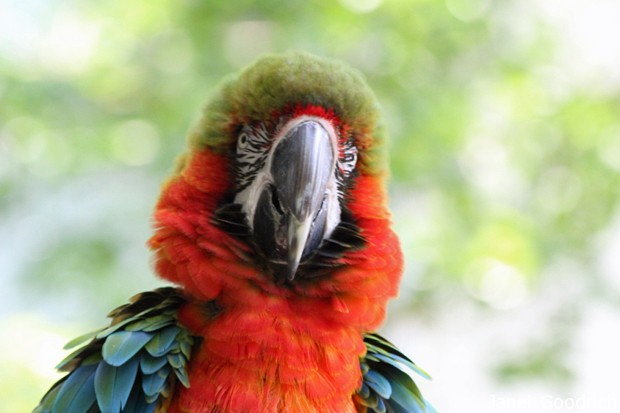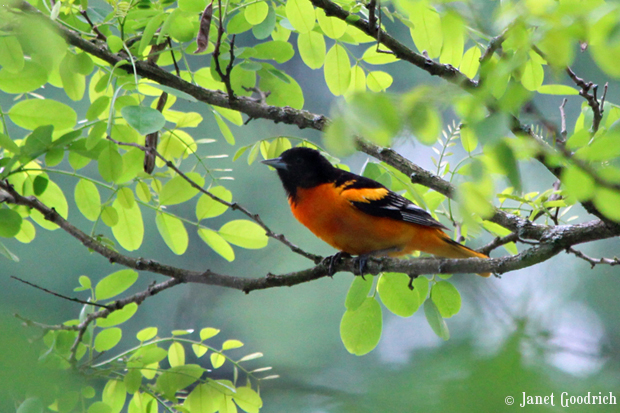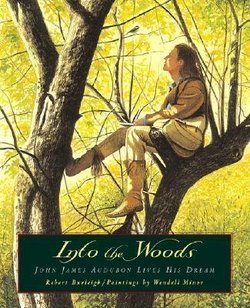Book Reviews
-
Flyaway
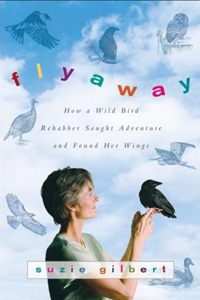 It’s not often that I laugh out loud while reading — laugh till tears trickle down my cheeks and my daughters get out of bed to find out what’s so funny.
It’s not often that I laugh out loud while reading — laugh till tears trickle down my cheeks and my daughters get out of bed to find out what’s so funny.It’s only slightly more common that a book moves me deeply enough to call out tears of the other kind. Reading is such an inward act, and the processing happens at such a slow pace, that my emotions seem to absorb and adjust without working their way out to the surface like this. As a Reading Action Figure, I’m normally a silent shape on the couch, eyes on the page, emitting a rustle every now and then when I shift position or turn a page.
A book that makes me both laugh and cry? Rare indeed. But Flyaway: How a Wild Bird Rehabber Sought Adventure and Found Her Wings does. Suzie Gilbert’s writing is lively, honest, and funny enough to prompt me to read sections aloud to my family. “Any new stories?” they would ask when they caught me reading. I could always comply. Her take on the animals she cares for, her insight into their personalities, and her frankness about her own struggles and adventures and passions along the way all make for a fascinating and often comical story.
But there is grief too: birds who don’t survive, exhaustion and difficulty balancing the demands of rehabbing and the rest of life, the perpetual tension of loving creatures enough to nurse them back to health only to release them and perhaps never see them again. Underlying it all is the awareness of the challenges and tragedies birds face, many of them a result of human activity. At times, Gilbert only resolves these tensions in her dreams, beautiful poetic visions of injured creatures flying strong and free. But the majority of the book traces her quest toward workable limits within which to engage in her passion to help wildlife without burning out or shortchanging her family.
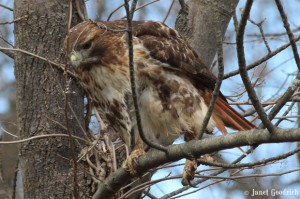 I’ve been interested in the world of bird rehabilitation since seeing this injured hawk at a popular local walking trail back in April. A mature redtail, he could still fly, though he was propping himself up in his perch with a mesh of twigs and when he took off we could see that one leg was dangling. I called a rehabber and was told that until the bird was grounded, he couldn’t pick it up. “But keep looking for it,” he advised. “Keep your eyes open.”
I’ve been interested in the world of bird rehabilitation since seeing this injured hawk at a popular local walking trail back in April. A mature redtail, he could still fly, though he was propping himself up in his perch with a mesh of twigs and when he took off we could see that one leg was dangling. I called a rehabber and was told that until the bird was grounded, he couldn’t pick it up. “But keep looking for it,” he advised. “Keep your eyes open.”We did. And we saw the hawk twice more, but that was it. What became of it? Did it have a nest somewhere with eggs, or nestlings? It has continued to bother me when I think of the hawk, suffering but unreachable.
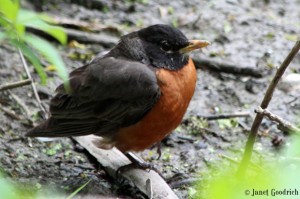 More recently, the girls and I came across a tailless robin and assumed it had lost its tail to a predator. Very likely it was someone’s outdoor cat — a subject Gilbert addresses strongly in Flyaway. I felt I had a kindred spirit as I read, because cats roaming through our yard have always infuriated me. We don’t have a cat, and don’t want one in our yard, prowling for birds and chipmunks. If you are a cat-lover, I support you wholeheartedly in it — as long as you keep your cat on your own property, as I do my dog.
More recently, the girls and I came across a tailless robin and assumed it had lost its tail to a predator. Very likely it was someone’s outdoor cat — a subject Gilbert addresses strongly in Flyaway. I felt I had a kindred spirit as I read, because cats roaming through our yard have always infuriated me. We don’t have a cat, and don’t want one in our yard, prowling for birds and chipmunks. If you are a cat-lover, I support you wholeheartedly in it — as long as you keep your cat on your own property, as I do my dog.But I digress. Back to the robin, about whom we called the same rehabber. He gave us the number of a woman who cares for injured songbirds and advised us to catch it and put it in a warm dark box will we could get it to her. “Throw some worms in there with it,” he recommended. “Good luck.”
We couldn’t catch it. It mustered enough flight power to motor to a willow branch that had broken and was leaning its base against the trunk and its end plunged into the pond a ways out. There the bird hopped unsteadily up to the trunk and out of reach. It had a robin friend (mate?) nearby with whom it discussed us indignantly, and waited us out.
So far, I’m a failure as a bird rescuer. Before reading this book, I felt sure I’d be a failure as a bird rehabber. I still think I would be. The knowledge required, as well as the plain courage and heart, are incredible. There are so many kinds of birds, and so many kinds of injuries. Suzie Gilbert and her network of wildlife rehabilitators are among the most enlightened generalists out there. I have enormous respect for them. And though the idea of joining that community is daunting, the idea of volunteering time and support seems like a possibility.
Suzie Gilbert’s website is here, and the children’s book Hawk Hill, our first introduction to her writing, is here. Both are worth checking out, as is Flyaway, an eloquent story about the perils and rewards of caring for living things.
-
John James Audubon for Children
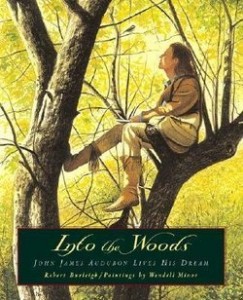 Into the Woods: John James Audubon Lives His Dream is structured fictionally as a letter from Audubon to his father. “Be a shopkeeper,” his father advises. Into the Woods represents the young man’s answer.
Into the Woods: John James Audubon Lives His Dream is structured fictionally as a letter from Audubon to his father. “Be a shopkeeper,” his father advises. Into the Woods represents the young man’s answer.The book is written as a combination of poetry and prose. Each page has a rhymed couplet from the young naturalist’s letter to his father back in France, describing his passion for observing and documenting the natural world through art. After several attempts in business, Audubon decides to follow his dream of exploring and depicting nature.
Accompanying each couplet is an excerpt from Audubon’s actual writings, describing the episode referred to — drawing a hawk or a dove, noting the changes to the land, his travels and ambitions. The illustrations by Wendell Minor are a beautiful complement to the text, and some of Audubon’s drawings are interspersed as well. The book concludes with a brief biographical note about John James Audubon and his significance.
My daughters found this book very appealing, and today dawns with my youngest planning a drawing session in which we’re all supposed to sit together drawing birds.
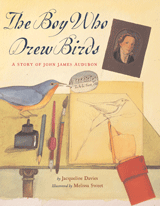 I couldn’t help but compare this book with The Boy Who Drew Birds, a book more narrowly focused on a period of the young Audubon’s life. Sent from France to his father’s Pennsylvania farm to escape being drawn into Napolean’s army, the 18-year-old boy wanders the countryside observing and wondering about nature. He even ties silver thread around the legs of some of the birds on his farm to see if they will return the following spring.
I couldn’t help but compare this book with The Boy Who Drew Birds, a book more narrowly focused on a period of the young Audubon’s life. Sent from France to his father’s Pennsylvania farm to escape being drawn into Napolean’s army, the 18-year-old boy wanders the countryside observing and wondering about nature. He even ties silver thread around the legs of some of the birds on his farm to see if they will return the following spring.Both tales are good introductions to the life of a naturalist and artist who has made great contributions to the fields of ornithology and nature study in general. The combination of artistic enterprise and interest in the outdoors, highlighted beautifully in both of these books, is sure to appeal to any child through ages 11-12.
Though these two are the only books on Audubon that we’ve read so far, if the girls show interest in further reading there are others to choose from:
- John James Audubon: Wildlife Artist by Peter Anderson
- Audubon: Painter of Birds in the Wild Frontier by Jennifer Armstrong
- First Impressions: John James Audubon by Peter Kastner
- John Audubon: Young Naturalist by Miriam E. Mason
- John James Audubon (Conservation Heroes) by Patrice Sherman

